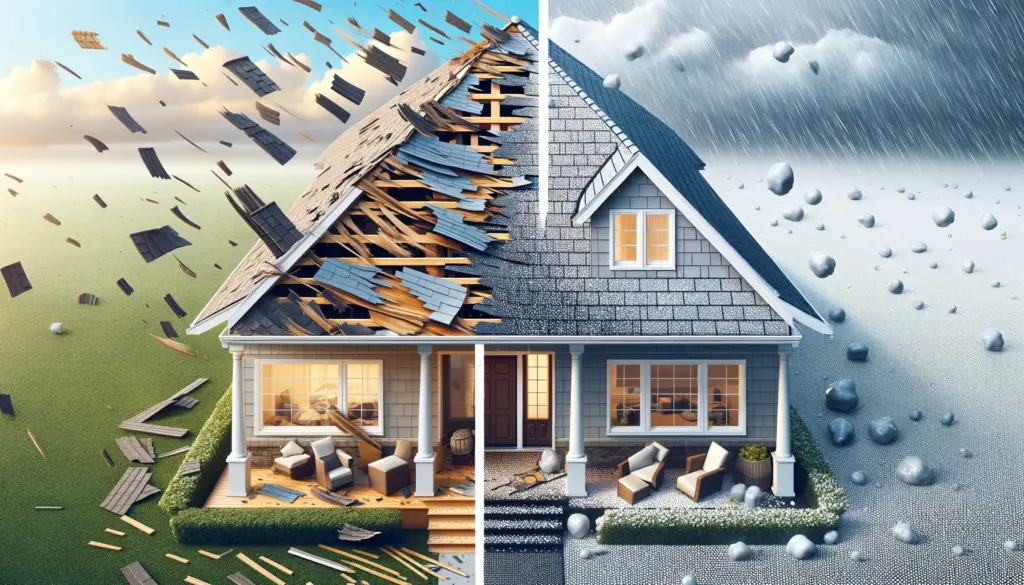Do I Have Hail or Wind Damage?
How can you tell if the last storm left you with hail or wind damage? Understanding the signs of such damage can help you address repairs swiftly, preventing further damage and potentially saving money.
A professional roofer can help to identify the signs of hail and wind damage, specifically in the Knoxville area, where storms can be particularly harsh.

Roof Repair for Wind or Hail Damage
Recognizing the signs of hail and wind damage is crucial for maintaining your roof’s condition and ensuring it continues to protect your home and family.
If you suspect damage after a storm, taking immediate steps to assess and repair your roof is essential for your home’s safety and integrity.
When to Contact a Professional
If you notice any signs of hail or wind damage, it’s crucial to contact a professional roofing contractor. Timely repairs are essential to prevent secondary damage such as leaks or structural weaknesses.
Preventive Measures
Regular Inspections: Schedule bi-annual inspections to catch and repair minor damages before they escalate.
Trim Trees: Prevent branches from damaging your roof during a storm by keeping trees well-trimmed.
Proper Installation: Ensure your roof is installed correctly and up to local building codes.
Signs of Hail Damage
Hail damage to roofs typically occurs during storms when hailstones, which can range from pea-sized to as large as a golf ball, strike the surface of roofing materials. The damage can vary significantly and includes:
Random Damage Pattern: Hail damage often has no uniform pattern.
Loss of Granules: A significant loss of granules may expose the roof felt, compromising the roof’s integrity.
Black Substrate: Hail hits can leave a black substrate on shingles, indicating deep impacts.
Soft Spots: These are areas in asphalt shingles that feel like bruised fruit when pressed.
Damage to Other Home Areas: Siding, gutters, and windows may also show signs of hail impact.
Signs of Wind Damage
Wind damage can be more insidious than hail, as it often leaves less visible evidence initially but can be just as destructive. Wind damage can include:
Missing Shingles: High winds can rip shingles from your roof, leading to visible bare patches.
Curling Shingles: The corners or edges of shingles may curl up due to wind exposure.
Creased Shingles: Wind can cause shingles to flap back and forth, creating a creased appearance.
Chimney Issues: Look for loose flashing or damage around chimneys, which can indicate wind damage.
Damaged Soffit or Fascia: Wind can cause cracks, loose or bent areas or even blow off loose fascia entirely.
FAQs about Hail or Wind Damage
The first signs include random patterns of denting, loss of granules, and soft spots on asphalt shingles.
Wind damage may not be immediately apparent but can include missing or curled shingles and creased shingles from wind lift.
While a visual inspection from the ground is possible using binoculars, climbing on the roof can be dangerous and is best left to professionals.
Contact a licensed and insured roofing contractor for a professional assessment and repair.
It’s recommended to have bi-annual inspections and additional checks after major storms.
Regular inspections, trimming nearby trees, and ensuring proper roof installation are key preventive measures.
Look for local, reputable contractors who are licensed, insured, and have good reviews in Tennessee.
Minor damage can lead to more significant issues like leaks or structural damage if not addressed.
Post-Snowstorm Action Plan
- Visual Inspection from Ground: Use binoculars to scan for obvious signs of damage such as missing shingles, visible dents, or any debris from the roof.
- Check the Attic: Look for signs of water intrusion or daylight shining through the roof.
- Use a Ladder Safely: If comfortable and safe, use a ladder to get a closer look at your roof, strictly following all safety guidelines to prevent accidents.
- Hire a Professional: For a thorough inspection, consider hiring a professional roofing contractor familiar with Knoxville’s weather patterns and roofing requirements.
- Document Damage: Take photos or videos of any damage you identify from the ground or attic.
- Check for Loose Material Around Pipes and Chimneys: Inspect the sealing and flashing around chimneys, vent pipes, and other roof protrusions.
- Inspect Gutters and Downspouts: Check gutters and downspouts for blockages or damages, as hail can dent these components and wind can dislodge them.
- Evaluate the Roof’s Age and Condition: Understanding the age and existing wear on your roof can help determine its vulnerability to damage and the urgency of repairs.
